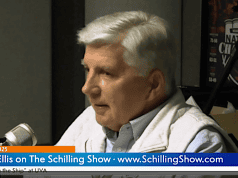After a lengthy and contentious approval process the Rivanna Water and Sewer Authority’s (RWSA) new 30-foot earthen dam proposal apparently doesn’t hold (enough) water.
In a clandestine April 21 email obtained by The Schilling Show (see below), Albemarle County Service Authority Member, Liz Palmer—a longtime proponent of a larger earthen dam—warns Charlottesville City Councilor Kristen Szakos of the smaller, 30-foot plan’s shortcomings:
“…after we meet the environmental obligations of the permit for River protection, the interim storage volume provides NO new water for growth. It does replace about 200 mg of storage at SFRR that will be lost due to sedimentation and that storage (in ever decreasing amounts) can be used by people in the interim between the time the new dam is finished and we meet a suggested trigger. That means that the vast majority of the new storage goes to rivers.” [Emphasis added]
Palmer continues by drubbing the currently approved 30-foot option as a wayward product of political compromise that benefits rivers but not people:
“The fact that this interim plan provides very little to people and a great deal to rivers is an unintended consequence of elected officials, who are not well versed in the objectives or methodologies of the plan, coming in at the 11th hour and altering a well thought out, holistic plan developed by competent engineers.” [Emphasis added]
The secret missive further elaborates that the Albemarle County Board of Supervisors conceded their 42-foot-or-bust “prerequisite” due to upcoming Charlottesville City Council elections and the inherent political ramifications of a no-compromise position by the Board:
“Those alterations were done in the spirit of compromise and, at least for the BOS, the fear that the upcoming City elections would hijack the process further.”
The release of Palmer’s letter and the “dam-ing” information within has deep ramifications for community stakeholders on all sides of the controversial issue— and it is certain to again “muddy the waters” of Charlottesville-Albemarle water-supply politics.
Read Liz Palmer’s confidential email to Kristen Szakos:
From: “Liz Palmer” <lpalmerl@embarqmail.com>
Date: April 21, 2011 3:21:03 PM CDT
To: <k.szakos@embarqmail.com>Subject: new info stream flows
Kristin,
This is a quick email to make sure you have some needed information. I will prepare a more formal email for the entire council before the next RWSA BOD meeting. I would appreciate this email not be shared for I have not carefully examined it for opportunities to be misconstrued or misquoted by opponents of the WSP. I haven’t checked my grammar either.
By now you have heard about Hydrologics’ most recent modeling of the new plan with the 30 ft rise on RMD and you have heard that after we meet the environmental obligations of the permit for River protection, the interim storage volume provides NO new water for growth. I t does replace about 200 mg of storage at SFRR that will be lost due to sedimentation and that storage (in ever decreasing amounts) can be used by people in the interim between the time the new dam is finished and we meet a suggested trigger. That means that the vast majority of the new storage goes to rivers. Exactly how much is hard to articulate for a host of reasons I will not go into here.
The fact that this interim plan provides very little to people and a great deal to rivers is an unintended consequence of elected officials, who are not well versed in the objectives or methodologies of the plan, coming in at the 11th hour and altering a well thought out, holistic plan developed by competent engineers. Those alterations were done in the spirit of compromise and, at least for the BOS, the fear that the upcoming City elections would hijack the process further. As for the ACSA, it was the feeling that once the county elected officials acted, we had to follow. But that is behind us now. I hope the message gets out that this is the “green” plan and that it has the support of most of the environmental community. I also hope that the plan isn’t ridiculed for being too “green”.
Some good news is that we now have repeatable and clear-cut numbers to quote. Here are the numbers that Hydrologics has modeled and feel are repeatable. The plan when fully implemented provides 65% for people and 35% for rivers.
HydroLogics recently looked at the 18.7 mgd condition with 42 ft raised pool, South Fork pipeline, and 200 mg useable storage in South Fork during the drought of record, and the storage in that condition was used about 65% for people and 35% for the rivers.
This is the biggest thing we have done for the long term health of the Rivanna watershed since the 1980 down zoning and it is a great victory for our natural environment and the future generations who will depend on that water source. We need to get that message out to citizens. I hope you will use your position to get that message across.
Change can be scary. People know what RMNA looks like. Some weren’t and are still not aware that we are damaging the watershed by excessive withdrawals and that it was likely to get worse as the community grows and as we experience climate change and the increased evapotranspiration. People know what they see. But city residents should be able to directly experience the improved navigability of the stretch of the Rivanna from Darden Tow to River View Park during moderately dry summers. And, depending on how we manage the system, they should be able to experience the difference in the summers by walking that stretch of the river.
Liz
Also a note. I attend a series of lectures given to legislators and the public by the American Meteorological Society in DC on Climate Change. Recently I went to one on modeling rain patterns as related to food production in the US. I was told by one of the speakers that Hydrologics is well known and well respected in the scientific community. I say this because I suspect their credibility has also been challenged by opponents.









Liz Palmer and her Red Herrings. Trying to pin the blame on others again.
1) The Dam is no good – False
2) The Sugar Hollow Pipeline is old, brittle and crumbling – False
3) There are heavy metals in the SFRR reservoir – False
4) The SFRR reservoir will cost $225 million to dredge – False
5) We are running out of water – False
Listening to this and spending millions and years on disproving it is lunacy.
Why did the Supervisors ever put her on ACSC? No credentials no education, no experience, just a long history of being wrong at great expense.
For some reason, no matter how hard she tries for the contrary, Liz Palmer’s bloomers are always showing to the public.
Dear Rob, Wasn’t the primary impulse of the Nature Con-
servancy water plan to restore or increase water to
streams and rivers? Will the Nature Conservancy be the
ultimate winner in this process?
Gary is on point here. The Nature Conservancy (TNC) says they targeted us in 2000. And their lobbyist has been active ever since.
TNC has control of more land than The National Park System. With assets into the billions, this PRIVATE tax free business has assets well into the billions. Many of its presidents and senior executives are current or former Goldman Sacks presidents or senior executives. This includes our former US Treasury Secretary, Henry (Hank) Paulson who administered the TARP program.
What do they get out of the program? Well it’s a very private organization so we can only guess. Somebody will “conserve” the land purchased by the Rate Payors at Buck Mountain which is required to offset the damage done at Ragged Mountain by RWSA. TNC is the likely reciprecant of these $millions. And the Big New Dam Project, including the Big New Uphill Powered Pipeline are parts of the TNC plan.
Check out some past activities as reported by The Washington Post. http://www.washingtonpost.com/wp-dyn/content/linkset/2007/11/16/LI2007111600631.html
Liz sure makes a good argument in this email for dredging FIRST. A new dam with a 30 foot rise just replaces lost capacity at South Fork Rivanna Reservoir? Uh, then why are we building it? Oh! because our elected officials ‘are not well versed in the objectives or methodologies of the [water plan]! You got that right, Liz.
If we dredge South Fork Rivanna Reservoir, we will (apparently) get just as much water as if we build a new dam with a 30 foot rise. Dredging will be cheaper than the cost of a new dam, plus I64 embankment, plus mitigation costs. And that’s not including the cost of the uphill pumping pipeline. And we don’t lose our assets of the reservoir at South Fork, or at Ragged Mountain.
What in the heck does that 65% for people and 35% for rivers mean anyway? Compared to what other options/plans exactly? What is 100%? The rain in a year? The water in the water table? The storage capacity? Is this a desirable ratio? Who knows? What assumptions is this based on – clearly that we will need 18.7 MGD in 50 years at least, a very dubious assumption given the methodologically flawed demand study. A new water demand estimate is due in November, which will give us important information.
Isn’t storage capacity storage capacity? So capacity at South Fork can “go to the rivers” too, right? So, why do we need to build a new dam?
If we need more water than dredging affords, we can repair the dam we have at Ragged Mt. and raise it as necessary. This method was determined to be safe and practical by Black and Veatch. Demand estimates will always be estimates, and this approach is flexible and timely.
Help Citizens for a Sustainable Water Plan make dredging an election issue and keep it on the table in current negotiations. Sign our petition (link at the top of the page) at cvillewater.info.
[…] for Albemarle County’s Rio District supervisor seat—has unwittingly defamed fellow Democrat Liz Palmer via a recent campaign […]
[…] the Samuel Miller District, the Progress will endorse incumbent Republican Duane Snow over Democrat Liz Palmer. They likely will cite Snow’s willingness to listen and his function as a mediator during […]